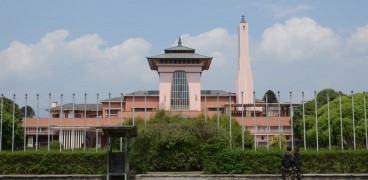Banke National Park, better known as Gift to the Earth, is Nepal’s tenth national parks. The conservational zone with an area of over 550 km sq lies on the Churia range in the Mid-Western part of Nepal.
The national park along with its neighbour Bardia National Park forms the Tiger Conservation Unit Bardia-Banke which covers an area of 1,518 sq km. Today in this article, we discuss all the natural features of the Banke National Park.
Location of Banke National Park in Nepal
The protected area lies in the mid-western region of Nepal. It is connected with the Suhelwa Wildlife Sanctuary of India with a transboundary landscape comprising of community and national forests.
In the west, it is connected to Bardia National Park which further joins with Kateriaghar Wildlife Sanctuary in India.

Banke: Untamed Wildlife Haven
Credit: dnpwc.gov.np
The core area of the park lies in the Chisapani-Obary section near the east-west highway and is bordered by Shiva Khola in the east, the Churia range in the north, and by Kohalpur-Surkhet highway in the west.
The national park covers an overall area of 550 km sq and is further surrounded by a buffer zone 344 sq km. The coordinates of the wildlife reserve are 27o 58’13” to 28o 21’26” in the north and 81o 39’29” to 82o 12’19” in the east.
A significant part, about 61.5% of the Banke National Park lies in Banke district while 38.5% of the buffer zone extends into the areas of Salyan and Dang.
Buffer Zone
To ensure the conservation spirit amongst the locals, the BaNP has started the participatory resource management in over 14 VDCs around the park.
Seven of these VDCs lie in the Banke district; Mahadevpuri, Rajhena, Chisapani, Kanchanpur, Khaskusum, Navbasta, and Kohalpur. The other remaining VDCs belong to the regions of Salyan (Kavrechaur, Kalimati Kalche, and Kalimati Rampur), Dang (Purandhara, Panchkule, and Goltauri), and Surkhet (Belawa) districts.
The people in these committees work accordingly to enhance the financial resources from the buffer zone and use it in the conservation of the national park, community development, skill enhancement, income generation, and conservation education program.
How to get to Banke National Park?
Suppose you wish to travel to Banke National Park then you can catch a regular flight or a bus which leaves from Kathmandu to Nepalgunj. Once on the ground, hire a taxi or catch a bus from Nepalgunj which takes you to the reserve’s headquarters.

Banke National Park Scenic Beauty
One can also reach the park’s headquarters from Mahendranagar and Dhangadi, but it would take you about 8 hrs and 7 hrs respectively.
Establishment of BaNP
The landscape was given the status of Gift to the Earth in 1998 after the government of Nepal decided to extend its commitment to Biodiversity conservation.
The wildlife reserve is the newest protected and national park in Nepal which was established on 12 of July 2010.
Habitat and Bio-diversity of Banke National Park
The ecosystem in the BaNP is divided into eight parts; Sal forest, savannahs and grasslands, deciduous Riverine forest, flood plain community, foothills of Chure and Bhabar range, and mixed hardwood forest.
90% of the conservational area is covered with thick forests of Sal (Shorea robusta), Khair (Acacia catechu), Sissoo (Dalbergia sissoo), and Karma.
Habitat
The eight main ecosystems of the region provide shelter to over 300 species of birds, 124 plants, 58 types of fish, 34 mammals, 24 reptiles, and seven varieties of amphibians.
Following the National Parks and Wildlife Conservation Act of 1973, the BaNP protects four species of rare birds(Bengal florican, black stork, lesser florican, and giant hornbill), 3 mammals (Royal Bengal tiger, four-horned antelope, and striped hyena), and two species of reptiles(python and gharial crocodile).

Banke Wildlife: Nature's Spectacle
Credit:Tigerencounter.com
The national parks main concern is to protect and conserve mammals like the Bengal tiger, four-horned antelope, and Asiatic elephants residing in the flood plain region of the park.
The Babai River on the north and Rapti River on its south serve as a lifeline to flora and fauna of the conservational area.
People of the Banke National Park
At present the Banke National Park holds about 4,861 households whose population exceeds more than 35,712 people. The chief residents of this area belong to the Tharu community, Brahmin, Magar, Chettri, Majhi, Tamang, and Gurung, who reside in the buffer zone.
The primary occupation of the people living in this region is agriculture, while some are also involved in trade and labour.
Climatic conditions of BaNP
The national park experiences three climatic seasons; winter, summer, and monsoon. From April to October, the days are usually warm and dry while the nights are cold and pleasant.
During April to June, the temperature in the Banke National Park reaches up to 45 degrees. Monsoon in the park start from July and lasts until the end of September.
Infrastructure in Banke National Park
The buffer zone outside the central wildlife reserve is facilitated with a few health posts while a Teaching hospital lies about 50 km away from the park’s headquarters.
Gas stations are scarce and are limited only to the highway; hence visitors are requested to have their arrangement before entering the park.

Banke National Park's Natural Wonders
and hotels are located on the outskirts of the park in its southern border and few other locations. The accommodations provide all the necessary amenities for the tourists.
Activities for Tourists in the Banke National Park:
- Jungle Safari in and around the national park
- Enjoy the Elephant ride around the protected area
- Go for hiking in the BaNP
- Take mesmerizing photos of the park and the animals wandering in the area
- Go Boating in the rivers of Rapti and Babai.
- Visit places like Surkhet Valley, Kakrebihar, Deutibajai Temple, Ghantghar, and Bheri Bridge.
For more details on the National parks of Nepal.
















